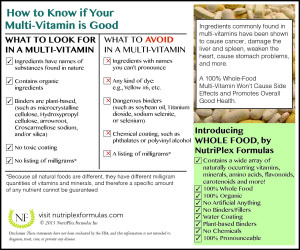In pursuit of good health, it’s common for many people to go to the supermarket or drugstore and pick up a multi-vitamin. A multi-vitamin is meant to benefit all systems of the body and maintain an overall state of good health. To fulfill these tall orders, multi-vitamins are supposed to provide an impressive amount of vitamins and minerals. Unfortunately, the sources of most multi-vitamins’ ingredients, as well as how the products are manufactured, make them more harmful to your health than good.
Most Multi-Vitamins Are Filled With Chemicals
Have you ever read the  ingredients on a bottle of multi-vitamins? Not the “Supplement Facts,” but the ingredients? It’s hard enough to pronounce them, let alone understand what they represent. That’s because they’re made of synthetic chemicals created in a lab to resemble nutrients. But the only nutrients our bodies recognize are found in nature’s real foods, and that’s because we’re beings that come from nature ourselves. And because synthetic chemicals like ascorbic acid, niacinamide, and ferrous furmerate aren’t found in nature, our bodies can’t use them as compatible fuel.
ingredients on a bottle of multi-vitamins? Not the “Supplement Facts,” but the ingredients? It’s hard enough to pronounce them, let alone understand what they represent. That’s because they’re made of synthetic chemicals created in a lab to resemble nutrients. But the only nutrients our bodies recognize are found in nature’s real foods, and that’s because we’re beings that come from nature ourselves. And because synthetic chemicals like ascorbic acid, niacinamide, and ferrous furmerate aren’t found in nature, our bodies can’t use them as compatible fuel.
Sure, a so-called natural form of these substances mimic nutrients that exist within organic matter, but making them in a lab is far from the same thing. And your body knows it.
In fact, studies have shown that synthetically produced vitamins are toxic to your body. And, fat-soluble vitamins A, E, D, and K are often included in multi-vitamins in high, unnatural doses – doses your body is unable to efficiently process – leading to a buildup in higher toxic levels that result in a host of side effects. Here’s an abbreviated list of possible side effects from fat-soluble, synthetic vitamins:
- Vitamin A: stomach pain, vomiting, headache, lethargy, respiratory tract infection, chronic liver disease
- Vitamin E: Breathing difficulties, tongue swelling, excessive bleeding, increased hypertension, decreased life span
- Vitamin D: hyperparathyroidism, tuberculosis, lymphoma
- Vitamin K: Liver damage, cancer
Frankenstein Pills
If there’s a chemical name for a non-synthetic substance listed on a bottle, then it’s known as an isolate. An isolate is created by extracting a single nutrient from its natural source, processing it and separating it from all the other nutrients contained within its original food. If isolates are used in a multi-vitamin, it means that these parts of foods have been grouped together to form a strange, Franken-vitamin. It’s akin to taking a nose, a hand, and a colon and sticking them together, expecting them to breathe, wave, and process waste. But there’s no way they can do those things without an intact respiratory, musculoskeletal, or digestive system. In the same way, it’s impossible to take vitamin A away from the other nutrients that originally accompanied it, and expect it to function properly. Therefore, an isolate has to pull the nutrients it needs to work properly from other places in your body, so that it can function at all. This creates deficiencies and results in health problems.
Processed Foods Are Dangerous, And So Are Processed Multi-Vitamins
As a rule of thumb, processed foods should be avoided: They’re foods that have been altered extensively in an attempt to make them edible – through the inclusion of harmful additives, artificial colors and flavorings, and chemicals. This process that takes them farther and farther away from nature, and whatever nutritive properties they once possessed become unrecognizable to the body. One sure-fire way to identify a processed food or supplement is by looking at its ingredient list: The more packed the list is with ingredients you wouldn’t recognize as one of nature’s foods, the more processed the product.
After reading this far, you might not be surprised to learn that most multi-vitamins are highly processed. Not only do they generally contain additives (such as modified cornstarch), artificial flavors and dyes (some of which are even derived from coal tar and are carcinogenic), and a long list of chemicals; they also contain such components as fillers/binders, flow agents, emulsifiers, separators, conditioners and coatings. Fillers/binders of a multi-vitamin hold the ingredients together. Unfortunately, most multi-vitamin manufacturers opt for binders hazardous to or health, such as selenium dioxide, a substance known to damage the spleen and liver, cause stomach disorders and nervousness, as well as other things. Additionally, the coatings of multi-vitamins may contain dangerous ingredients, such as phthalates, an ingredient used to make plastic softer and more pliable.
What To Do
Let’s recall the purpose of a multi-vitamin: To support all systems of the body nutritionally, for the purpose of achieving and maintaining good health. If, after reading your multi-vitamin’s label, you find it contains isolates, synthetics, fillers, artificial colors or flavors, chemicals, or just a long list of things you’d only hear in an advanced chemistry class, chances are it’s not only NOT nourishing you or supporting your system, but it’s also damaging your health.
If you’re looking for a multi-vitamin that will fulfill its purpose, opt for a whole food complex. But beware: A lot of multi-vitamins claim to be whole food when their labels reveal lists of vitamin names (meaning, they’re full of isolates and synthetics, just the same). Find a multi-vitamin supplement with a list of food ingredients that are pronounceable and recognizable, such as NutriPlex Formulas’ Whole Food – a 100% whole food formula that’s side-effect free because it contains nothing but nutrient-dense foods in pure, chemical-free form.
http://www.doctorsresearch.com/articles3.html
http://draxe.com/4-dangerous-and-common-vitamin-fillers-you-must-avoid/
http://articles.mercola.com/sites/articles/archive/2011/08/22/is-your-multivitamin-toxic.aspx
